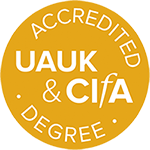Current filters applied:
- (-) Remove Medieval filter Medieval
- (-) Remove Science, Technology and Innovation filter Science, Technology and Innovation
Displaying 14 projects
A multi-disciplinary research project focusing on St. John's Hospital cemetery, Cambridge, with an aim to learn more about the lives of the medieval urban poor during the bubonic plague epidemic known as the Black Death.
The archaeology of Sub-Saharan Africa is rapidly gaining momentum, thanks to renewed efforts to decolonise and empower indigenous narratives of agency and creativity that have been bolstered further by the increasing application of scientific methods. However, important challenges remain. One is...
This project aims to study the crucibles and finished metal objects recently recovered from the Great Zimbabwe World Heritage site, using techniques from earth and materials sciences.
The bioarchaeological characterization of disabled individuals from the past is particularly challenging because it pushes the boundaries of the interpretation of pathologies recognisable on human remains. With my project, namely B-CARED, I will investigate the bioarchaeological approaches for...
The aim of the ERC project Beasts to Craft (B2C) is to document the biological and craft records in parchment in order to reveal the entangled histories of improvement and parchment production in Europe from 500-1900 AD.
This research employs archaeobotanical and biomolecular methods to reconstruct ancient agropastoral change over the first millennium CE in two microregions, the Aravah valley along the southern border of modern Israel-Jordan and the adjacent Negev Highlands. The region witnessed unprecedented...
The last decades have witnessed marked achievements of STEM in understanding the remains of humans, animals, and plants from the past by analyzing different materials, both inorganic and organic. These developments have opened-up the great potential for increasing our understanding of cultural...
Taking as its starting point the radically new perspective offered by recent archaeological discoveries at Rendlesham in SE Suffolk, and with the East Anglian kingdom as the primary case study, this interdisciplinary project (running 2017-2020) aims to establish a new understanding of pathways to...
Image: Ancient pastoralist settlement viewed from the air, Amboseli, Kenya. Photo: P. Lane. Mapping Africa's – Endangered Archaeological Sites and Monuments (maeasam.org) project aims to identify and document endangered archaeological heritage sites across Africa using a combination of remote...
The Mapping Archaeological Heritage in South Asia ( MAHSA ) project, now in its Phase 2, will continue to document the endangered archaeology and cultural heritage of the Indus River Basin and the surrounding areas and publish this information in an Open Access Arches geospatial database. Over the...
During the medieval and renaissance periods, the Low Countries were a key region for trade, international finance, and the arts. Cities such as Bruges, Ghent, Brussels, Amsterdam and Leiden developed large populations, and with high population comes the problems of sanitation. Medieval populations...
SILKGLASS is a Horizon Europe MSCA-PF fellowship funded by UKRI and hosted by the McDonald Institute for Archaeological Research, University of Cambridge. Central Asia is traditionally seen as a passive Silk Roads throughway rather than an active and creative node. SILKGLASS seeks to investigate...
Cambridge is home to world-leading researchers across archaeological science, technical art history and heritage science, based at Department of Archaeology, the Fitzwilliam Museum, and the Hamilton Kerr Institute, among others. There are multiple synergies across these institutions in terms of...
This project will challenge the extant model on the beginning and spread of Islamic glazes, which asserts that they were all derived from the Middle East and spread with Arab expansion, and that new technologies were adopted passively by conquered societies. It will include a variety of glazed ware types dating to the 9th to 13th centuries CE from different regions of Central Asia.


